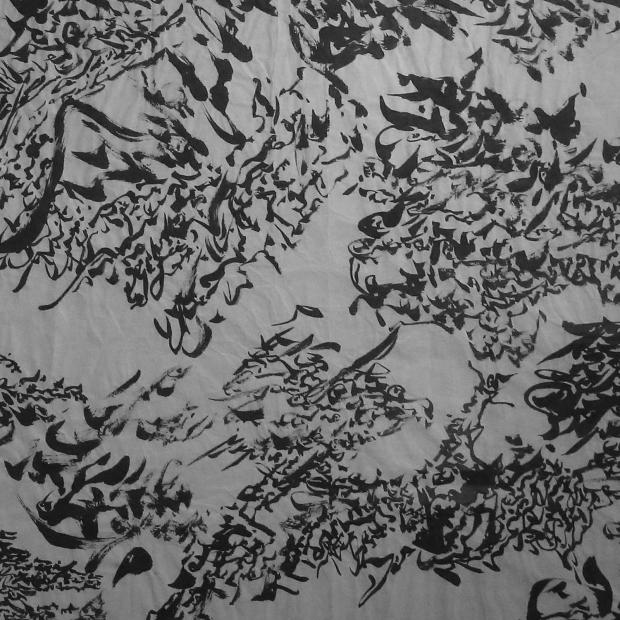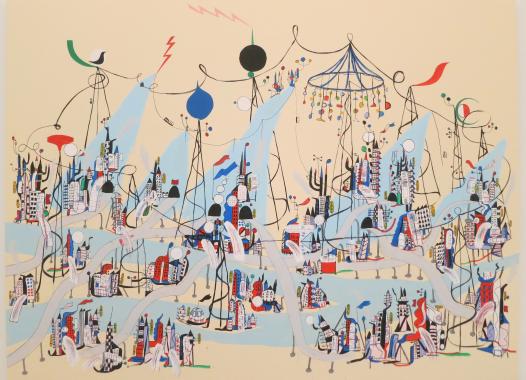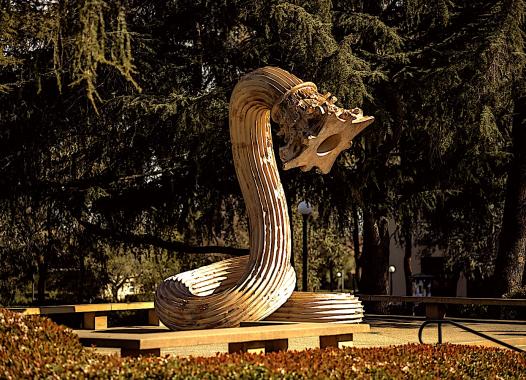
Wittgenstein’s theory of language provides a good methodology for making sense of maʿna in Classical Arabic.

Oakland, California
322
TRANSLATION
Thus far I have endeavored to present my reading of maʿna as a word with a single meaning as relatively uncontroversial.* I believe that this is an accurate reflection of the word’s status for those who used it in the eleventh century and before. Only someone writing a book that sought to expose minute semantic differences where they had been previously denied or ignored would notice, as we have seen Abu Hilal notice, any dissonance in the use of the word. But my approach stands in stark contrast to the consensus in much of the secondary literature, where maʿna is either discussed as vague and imprecise, or else is divided up into separate and mutually incompatible meanings. My core criticism of both of these approaches is that they rest on vectors of maʿna that are unmarked in the original texts, and unremarked upon by the scholars who wrote those texts. I think that the only way that we can read maʿna as vague or imprecise is to think likewise that a word in English such as “play” is also vague and imprecise because it can be put to so many different uses; one can play tag in the morning and then watch someone else play Hamlet in the evening.
I accept that dividing maʿna up into separate meanings is a legitimate translation methodology, but while I have learned a great deal from scholars who have done just that, it is a methodology that has risks. If what we are trying to understand is a conceptual vocabulary that we do not share, any translation technique that slices up the original vocabulary into new divisions risks domesticating that alien conceptual vocabulary to our own. Concepts with which we are not familiar thereby appear familiar, but as they do so they change, and a gap appears between us and the use that the original authors made of their words. It is true that this gap is an inevitable part of translation, but I think that it is our job to minimize it. Philology should be aware of the challenges (which means basically being aware that time travel is impossible), but it should also be committed to playing, as well as we possibly can, the language games of the past.
Language Use (Wittgenstein)
The idea of language as a game that is played comes from the later work of the twentieth-century philosopher Ludwig Wittgenstein. I have found his ideas about how language works to be very helpful in the struggle to translate. At the heart of his account lies the conviction that what matters most for language is usage. This means that the answer to the question, “What is language?” is that a language (in our case the Arabic language used by eleventh-century scholars) is the use that people make of it, not some set of fixed or fluid meanings. If we choose to agree with Wittgenstein, we should no longer say, “Maʿna means one thing” or “Maʿna has two or more meanings.” Instead we only ask, “How did these people use the word maʿna?” At stake here is the question of whether or not one subscribes to a theory of language in which meanings exist outside the context of their use. Wittgenstein did not. However, if we say, “Maʿna means one thing” or “Maʿna has two or more meanings,” then we are subscribing to such a theory: for these statements to make sense, meanings need to have an existence separate from their ordinary usage, an existence that we can map and thereby determine. In the years since Wittgenstein’s death and the posthumous publication of Philosophical Investigations, his theory of language, and his denial that meanings have any such existence, has not met with universal acceptance. Nevertheless, I think that it provides a good methodology for making sense of maʿna in Classical Arabic.
This is why, in the preceding chapter on precedents for the use of maʿna, I spent little time on the Arabic lexicographical tradition. I did not want that kind of picture of language to dominate the reader’s understanding of maʿna. I did not want the reader to think that there was some truth in the etymology of maʿna, or in the Semitic root of ʿ-n-y, or in a dictionary definition, that may have guided all the uses scholars made of that popular vocabulary item. Instead, what I wanted to do was lay out a roughly representative selection of those uses in order that it may act as an orientation to the subject matter of this book: the theories of ar-Raghib, Ibn Furak, Ibn Sina, and al-Jurjani about how language worked. These theories about language consisted of a great deal of use of the word maʿna in serious and complex games played in the spaces between God and the poets. There is a double irony in my use of theory here: Wittgenstein would have hated the Arabic assumptions about maʿna; they represent exactly the kind of stable structure that he thought did not exist. The Arabic lexicographers, for their part, would no doubt reject my attempt to abandon their dictionary etymologies in favour of Wittgenstein’s focus on usage. But I think we do need a theory of language, a tentative universal diagnosis of what linguistic reality is, before we start to translate. Wittgenstein provides that for me; his theory of language supports my philological practice.
For Wittgenstein in Philosophical Investigations, use is all that matters. Use is the only part of language that can be shown to actually exist. This is the central conclusion of Wittgenstein’s late work, and it has guided my reading of the work of Arabic theorists who used the word maʿna unmarked, over and over again, in a series of ways that I consider to be stable, rigorous, and cohesive. This is exactly how Wittgenstein thinks language works. He does not think that language consists of meanings that can be identified and enumerated in fixed fields of reference. He thinks that the language games human beings play, the actual usage we make of words, is the only place to which we can turn when we want to give an account of language. He also thinks that usage is often stable, rigorous, and cohesive, because how else can a meaningful game be played?
In Philosophical Investigations, a book in which Wittgenstein asks questions and tests out possible descriptions in order to destroy any idea of a fixed realm of reference, I read #204 as a moment when he takes a stand and makes a commitment to the universal fact that what mankind does is play games:[1]
As things are I can, for example, invent a game that is never played by anyone.—But would the following be possible too: mankind has never played any games; once, however, someone invented a game—which no one ever played?
The games are, of course, language games. One can invent a language that is never spoken by anyone. But ours is not a world in which the only language game ever to have existed was never played. To put it the other way around, in our world mankind inevitably plays language games (although not necessarily everyone all the time). Wittgenstein’s rhetorical question is a reductio ad absurdum, and his point is a double one: people always play language games, and language games are always played by people. They exist only in their being played, not in the abstract. Language exists in usage, not as a formal structure.
The question then becomes one of rules, because Wittgenstein claims that every game from chess to ring-a-ring-a-roses has rules. The players know at least some of the rules in advance; rules are by definition used on multiple occasions, and rules also have to be obeyed by multiple players.[2] There are also, as we saw in the previous chapter, different sorts of game. Eleventh-century Arabic scholarship contains games in which the rules are laid out and debated, such as those for dialectical debate performances or for grammar. It also contains games where the rules are not laid out but rather are known iteratively by the players, as they play:[3]
Doesn’t the analogy between language and games throw light here? We can easily imagine people amusing themselves in a field by playing with a ball so as to start various existing games, but playing many without finishing them and in between throwing the ball aimlessly into the air, chasing one another with the ball and bombarding one another for a joke and so on. And now someone says: The whole time they are playing a ball-game and following definite rules at every throw.
And is there not also the case where we play and—make up the rules as we go along? And there is even one where we alter them—as we go along.
In this book, those people are ar-Raghib, Ibn Furak, Ibn Sina, and al-Jurjani; the field is eleventh-century Arabic scholarship, and the ball is maʿna. I find that Wittgenstein’s account of a language game is the best way to give an account of the usage of maʿna in the works that I have read.
Wittgenstein writes that “when we do philosophy we are like savages, primitive people, who hear the expressions of civilized men, put a false interpretation on them, and then draw the queerest conclusions.”[4] (Ar-Raghib and his contemporaries would agree with the heedless division of humanity into civilized and savage; in addition to their patriarchy, eleventh-century Arabic scholars tend to exhibit unselfconscious racism.) At this point in Philosophical Investigations, Wittgenstein is complaining about the imprecise way philosophers use language. He explains his criticism with an example, in which philosophers are describing the way an inanimate object, a machine, has something that they call “possibility of movement.” Wittgenstein objects to this description. He says that a piece of machinery such as an engine, when not switched on or in operation, has for us some picture or history of experience that is its future movement. This “empirical condition” of the various parts being ready to move and not being broken or misaligned is “like a shadow of the movement itself.” But what bothers Wittgenstein is that philosophers cover all this up with the blanket term “possibility of movement.” They replace Wittgenstein’s own multifaceted explanation, which he thinks is perfectly clear, with a single neologism. We are therefore effective language users when we say (updating Wittgenstein’s example), “This mobile phone works” even when it is switched off. Our words are simple, but their usage in this case communicates a particular shadow picture of a phone-and-context-specific act of working that hasn’t actually empirically happened, may not happen, and is (as this sentence shows) not really amenable to paraphrase.
This is why Wittgenstein complains that civilized men use words like “works” and then philosophers come along like savages and misinterpret them with phrases like “possibility of movement.” Ibn Furak, ar-Raghib, Ibn Sina, and al-Jurjani are the civilized men here, and we are the savages. They used simple words like maʿna to talk about universal things like language and human minds very effectively, and then we come along and risk confusing their work, and ourselves, with a whole host of technical terms (sense, nominatum, denotation, illocution, signifier, signified, etc.), or alternatively with an after-the-fact assertion of conflicting meanings. (Maʿna means this there, but that here, and so on.) Robyn Creswell, talking about poetry rather than theory, recently warned against thinking of Arabic as “a strange and potentially deranged exotic, whose speech shows no ability to connect one thought to another.”[5] Ibn Furak, ar-Raghib, Ibn Sina, and al-Jurjani used maʿna to connect their thoughts with an unremarked-upon ease.
Wittgenstein was talking about machines because in Philosophical Investigations he was gradually establishing the machine as a metaphor for how language works. What interested him about machines was how they are both predictable and inert at the same time. They are like a number series, in which the subsequent unwritten numbers are both there and not there; so where are they?[6] This is the same question he asks about sentences and what happens when we read. The thrust of his argument is to deny that there is anything at all fixed to which words refer. His proof is that however hard he works to comprehend and explain a stable place in which meaning could reside, language is like the future numbers in the series and the future operations of the machine: it remains inexplicable without resorting to falsification. His examples of falsification are cover-ups such as “it has the possibility of movement” for the machine or “he understands the principle of the series” for the numbers.[7] He thinks that these are meaningless statements, whereas “This phone works” or “one, two, three, four . . .” is effective language in action. I think that the Arabic theory I have read for this book is also effective language in action, and I think we have to recognize it as such before we translate it.
Wittgenstein uses the machine as a metaphor for language, not as a model. It is not that language is like a machine, but that thinking about how machines work helps us think about how language works. It helps us because machines tend to be understood as things that work, not things that stand still. Language is the same: “The confusions which occupy us arise when language is like an engine idling, not when it is doing work.”[8] Wittgenstein’s famous explanation of signification as family resemblances is a metaphor too, not a model. Wittgenstein does not, I believe, think that a word can refer to clusters of ideas and that those ideas have family resemblances to each other. Instead, when it comes to a word like “game,” which can refer to anything from ring-a-ring-a-roses to chess, he can “think of no better [metaphorical] expression to characterize these similarities than ‘family resemblances,’” because the members of human families exhibit overlapping characteristics, like games.[9] It is not that there are things to which words refer that actually do have family resemblances to each other, just as it is not the case that language is actually a machine with fixed and permanent components.
Maʿna does not have different meanings that share family resemblances, nor is it a fixed and permanent component of some linguistic machine. It is the ball in an eleventh-century language game. We need to read it as such, and then translate. Here, Wittgenstein’s own practice provides some useful precedent for my experimental translation of the word maʿna as “mental content.” Maʿna is not exactly the same thing all the time, just as Wittgenstein does not claim that a “game” is always exactly the same thing; sometimes it is ring-a-ring-a-roses, and sometimes it is chess. Maʿna also does not mean lots of different incompatible things, for a game of ring-a-ring-a-roses and a game of chess are both games, both the same thing (whereas the bank of a river and the bank in which one puts one’s money are not the same thing at all). Another example is “read”; whether one is reading this book or reading the expression on someone’s face, one is still reading. One could, as Wittgenstein suggests, talk about the relationships between ring-a-ring-a-roses and chess, or between Ibn Furak’s theological maʿna and al-Jurjani’s literary-critical maʿna, as family resemblances, but this would be just a suggestive metaphor, rooted in Wittgenstein’s twentieth-century mental picture of how different family members he had seen resembled and differed from each other. It is far better to follow the strategy on which Wittgenstein settled and track how eleventh-century Arabic scholars used the word maʿna in their language games. My only a priori commitment is to the game itself; that is, I read the Arabic as if it made sense to the scholars writing it.
With this commitment in mind, it is worth returning briefly to Abu Hilal’s explanation for the use of maʿna for both prelinguistic cognition and for the qualities or attributes of things. Where Wittgenstein reached for the metaphor of family resemblances, Abu Hilal reached for the concept of tawassuʿ, semantic extension. The reason for this difference in strategy is that Abu Hilal was committed to a lexically based theory of meaning, a structural account of language based on references made to maʿani, which would have been anathema to Wittgenstein. Here is that irony: when the Arabic scholars used maʿna to make sense of language and the world, they usually did so by positing exactly the kind of fixed cognitive and linguistic objects of which Wittgenstein was contemptuous. So Abu Hilal wrote that variation in use could sometimes be explained by a stretching, broadening, or extension of a word’s semantic field of reference. But Wittgenstein rejected the idea that any such account of meaning could be correct; he rejected the existence of the structure that Abu Hilal was trying to stretch. Wittgenstein famously wrote, “You say: the point isn’t the word, but its meaning, and you think of the meaning as a thing of the same kind as the word, though also different from the word. Here the word, there the meaning. The money, and the cow that you can buy with it.”[10] This is exactly what the Arabic theorists did. Abu Hilal thought that vocal forms referred to mental contents in fixed patterns that allowed for some stretching. Wittgenstein thought such accounts were nonsense.
But I use Wittgenstein because he provides me with a strategy for translation, not because he believed in the same model of language reference as eleventh-century Arabic scholars. The value of the translation strategy that Wittgenstein provides is that it does not allow us to simply replicate the accounts of reference in the work of the Arabic lexicographers, and it also refuses to allow us to substitute our own corrected accounts of reference mechanisms in place of theirs. Instead we need to ask, over and over again, “What did they use maʿna to do?” I think asking this question has produced some valuable results, and this makes me in the end more optimistic about translation than was Wittgenstein. He thought that even with mastery of a strange country’s language, we still could not really understand the people: “If a lion could talk, we could not understand him.”[11] My task in this book is to make Arabic lions talk.
Core Conceptual Vocabulary (Kuhn)
Kuhn’s work on translation and on the incommensurability of conceptual vocabularies often seems to me as if it was written specifically for the problem of translating eleventh-century Arabic theories. He wrote that “incommensurability [is] always local, restricted to small sets of interrelated terms, ordinarily terms which must be learned together.”[12] This is exactly the problem we face with lafz, maʿna, and haqiqah, a small set of interrelated terms that need to be learned together and are not commensurable with any set of terms in English. The problem is not that the Arabic scholars were doing something completely incompatible with twenty-first-century literary criticism or philosophy of language. After all, they too were socialized human beings using language to think about words, ideas, and things. Kuhn helps us notice that problems arise “when these terms or some other small clusters enter the text” and have an influence on our understanding of the text disproportionate to their small size and apparent simplicity. The problem is that they appear a great deal: “The most populous part of the lexicon . . . contains concepts learned in contrast sets and carrying normic expectations”;[13] we meet lafz, maʿna, and haqiqah all the time when we read eleventh-century Arabic, and yet when we try to transpose them directly into English they seem to start to mean everything, anything, and nothing (as more than one colleague has remarked).
Kuhn knew what this incommensurability felt like. He famously related his experience as a graduate student struggling with Aristotle’s physics and thinking it impossible that someone thought to be so intelligent could write such nonsense. Kuhn realized he needed to change “my way of reading, altering some of the concepts—the meanings of the words—that I, coming from a later age, had brought with me to the text.”[14] As Alexander Bird puts it: “The appearance of absurdity was generated by the impossibility of properly translating Aristotelian ideas into a language inherited from Newton.”[15] This is precisely the problem we face with the gap between our own vocabulary and that of eleventh-century Arabic.
The problem matches Kuhn’s diagnosis: “Statements are not accessible by means of a translation that uses the current lexicon, not even if the list of words it contains is expanded by the addition of selected terms.”[16] We cannot therefore simply solve the translation problem by transliterating key Arabic words and typing them into our European analyses. That would amount to nothing more than an expansion, by a few select terms, of our lexicon. It is for this reason that I propose a thought experiment rather than a translation mechanism. We should always try to think of maʿna as mental content, and this thought process is what matters. The reason I have invariably translated maʿna as “mental content” rather than relying on transliteration is that I want to make sure this thought experiment happens. Maʿna, the romanized and italicized Arabic word, will not by itself ensure that readers think of maʿna as some content that is in the mind. But the jarring neologism of “mental content” may help force the issue. The reason why I want to force the issue is that, following Wittgenstein, I think that if eleventh-century Arabic usage invariably uses maʿna without qualification or explanation, then to capture that usage we need to replicate the word’s unchanging omnipresence. The reason I want to use “mental content” rather than the romanized maʿna is that, following Kuhn, this word is an item of core conceptual vocabulary that affects the entire thought system that uses it: we cannot simply slot it into our own English conceptual vocabulary as a foreign loanword. We need to experiment with letting this Arabic word change the way we think about language, mind, and reality. It is a burdensome process; translation has a chance of succeeding, Kuhn thinks, only when it ceases to be needed: at the end of a long process of language learning the reader becomes bilingual in the two conceptual vocabularies. (I consider elsewhere how al-Jurjani’s bilingualism helped shape his translation theory.)[17] But even then the translation is limited to the language learners’ conversations with themselves, for when new bilinguals speak to others they “must always remember within which community discourse is occurring. The use of one taxonomy to make statements to someone who uses the other places communication at risk.”[18]
Kuhn’s work helps us take Wittgenstein’s insights about language in general and apply them to the specific problem of translating theories. For this is not a book about ordinary language in eleventh-century Arabic but rather a book about the scholarly theory of ar-Raghib, Ibn Furak, Ibn Sina, and al-Jurjani. Maʿna (mental content) is a piece of core conceptual vocabulary, and it is part of a small contrast pair with lafz (vocal form). Haqiqah (accurate, getting it right) is a term that can be grasped only when maʿna is understood. Compare this with Kuhn’s account of “liquid,” which requires mastery of “solid” and “gas” in order to be learned, or “force,” which “must be learned with terms like ‘mass’ and ‘weight.’” Indeed, “one cannot learn ‘force’ without recourse to Hooke’s law and either Newton’s three laws of motion or else his first and third laws together with the law of gravity.”[19] Kuhn is here explaining that words like “liquid” and “force,” which seem so obvious and ordinary to us, are in fact parts of sets of interrelated terms that need to be grasped as sets in use. Grasping them also requires knowledge of the historical theories that contributed to their meaning in our lexicon. We cannot understand “force” as it is used in Anglophone science today without Newton, and we cannot understand maʿna as it was used in eleventh-century literary theory without Sibawayh and others.
Kuhn goes on to show that polysemy is not a successful workaround. It may seem as if we could capture the use of maʿna across the broad range of disciplines reviewed in the previous pages by positing multiple terms: maʿna1 for grammar, maʿna2for literary criticism, and maʿna3for theology, for example. But maʿna is (like the example Kuhn was using, “liquid”) what Anglophone philosophers of language call “a kind term”: words that classify or taxonomize the world into classes/kinds, so that one can say “that particular thing is a maʿna” or “that particular thing is a liquid.”[20] (Cf. a recent article by Rodrigo Adem on the effects of another kind term across genres of scholarship: the word for explicit textual evidence, nass.)[21] Because maʿna is a kind term, different uses of maʿna will tend to overlap: one may have an instance of grammatical maʿna that was also theological. In addition to the problem of overlap, kind terms are also often what Kuhn calls “normic”; they create expectations about the future. These are expectations for what a particular term will be used to refer to, and these expectations need to be compatible within a speech community.
Translation needs to align the expectations about what a term will be used to do. And this process of alignment is further complicated by the fact that in European languages we already have our own different core conceptual vocabulary, which we use when dealing with the same subjects. We can say that something connected to language or thought is “a meaning” or “a referent,” or following Ferdinand de Saussure, “a sign,” and when we use these kind terms we create sets of expectations wholly unconnected to the expectations created by Arabic kind terms functioning in their own contrast sets. This means that, as Kuhn said, we “describe the world differently and make different generalizations about it.”[22] We see “epistemology” and “ontology” where they saw maʿna. We live in different worlds: “If the terms to be imported are kind terms that overlap kind terms already in place, no importation is possible, at least no importation which allows both terms to retain their meaning, their projectability, their status as kind terms.”[23]
Kuhn’s work on the process of epistemological and scientific change is just that; it is not an account of a changing ontology but an account of changes in human beings’ descriptions of what is out there in the world. It is an appropriate frame for my experiment in this book because the gap between Arabic eleventh-century conceptualizations of language and twenty-first-century Anglophone or European conceptualizations of language is, in the same way, an epistemological and not an ontological gap. The fact that language exists as a means of communication between human beings out in the world remains as true today as it was south of the Caspian Sea a millennium ago. And the human desire to understand how language works remains just as strong. Kuhn also reminds us of what is at stake in the process of description, particularly when it comes to those central, small, interrelated sets of kind terms that create expectations. The centrality of kind terms comes from the fact that they are used to carve reality at the joints; when we use them, we are making the claim that our language divides up the world accurately. This metaphor of carving nature is an old one, dating back at least to Plato’s Phaedrus, where Socrates explained a pair of methodological principles: first the bringing together of scattered particulars; and second a cutting through of shapes and forms at the joints.[24] Kuhn sees this epistemological claim as itself helping to create the world being described.[25] Maʿna, this piece of conceptual vocabulary for which we do not have an equivalent in European languages, is therefore in itself an act of carving. It was part of the lexicon, the core conceptual vocabulary, of the Arabic scholars who used it and “what this part of their lexicons supplies to community members is a set of learned expectations about the similarities and differences between the objects and situations that populate their world.”[26] Maʿna was a kind term that enabled the scholars who used it to say that something was a maʿna of something else and thereby carve reality at the joints. We do not carve at the same joints; we stand over the same carcass with the knife but disagree about where to make the cut.
Kuhn also provides us with some helpful clarity about the degrees of disagreement within conceptual vocabularies and scientific communities. As the preceding chapter on precedents has shown, it is not the case that every Arabic scholar who used the word maʿna did so to point at exactly the same object all the time. Wittgenstein has given us an explanation of how their language games could still function despite this, just as we are able in English to use the words “game” and “read” in a variety of different ways. Kuhn then gives us what could easily be a map of premodern Arabic use of the word maʿna: kind terms create expectations, but in a single community a kind term does not need to always create exactly the same expectations. The work maʿna does may differ from theology to literary criticism: scholars from different disciplines “may know different things about [maʿani] . . . , but they will both pick out the same things, and they can learn more about those things from each other.”[27] All Arabic scholars were using maʿna within the same structure: “The lexicons of the various members of a speech community may vary in the expectations they induce, but they must all have the same structure. If they do not, then mutual incomprehension and an ultimate breakdown of communication will result.”[28] The test of whether the language game worked is whether scholars from two disciplines ever had “incompatible expectations,” with the result that one of them chose to “apply the term to a reference to which the other categorically denies that it applie[d].”[29] I have never seen this happen with maʿna in an Arabic text from any disciplines of premodern scholarship, and it is my contention that if it had happened, then these lexically minded scholars would have noticed and discussed the problem. Communication did not break down over maʿna; on the contrary the use of maʿna redoubled and multiplied along with the continued explosion of text across the subsequent millennium. The language game continued to be played. Maʿna was a core part of a shared lexical structure for eleventh-century Arabic scholars; it had a history of shared precedent stretching back to Sibawayh, and it had a future in the madrasa. The fact of language usage, the existence of the scholarly language game, kept its meaning stable and productive. Everyone knew what maʿna was; everyone used it to carve their reality. We are the only people who don’t know; outside the language game and outside the speech community, we need translation.
Maʿna was often used in theoretical statements about what language is and how language works. It is what we may call a scientific, or even an abstract term. This makes it arguably harder to translate than simple descriptive language used for physical objects. Kuhn compared the process of translating such scientific terms to the process of translating literature, but this was a reach by a historian of science that casually and incorrectly allowed literature to represent difficulty, turbidity, and ambiguity. (Creswell, as noted above, recently defended Arabic literature on this very question.)[30] Willard Van Orman Quine’s ideas about translation are more useful than Kuhn’s here. Like Wittgenstein, Quine did not believe in a sphere of fixed meanings. He thought that the only way meanings could actually be shared between different people would be if those different people shared a single set of nerve endings.[31] Human beings do not share nerve endings, and so the only way they can know what other humans mean is by looking at what they do. This makes the truth of translation, and truth itself in any language, a matter of the “observable reactions of speakers to language and the world . . . patterns of [observed] assent and dissent.”[32] This is easier with simple sentences about physical objects, and harder with abstract theoretical claims: “Observation sentences peel nicely; their meanings, stimulus meanings, emerge absolute and free of all residual verbal taint. Theoretical sentences such as ‘Neutrinos lack mass,’ or the law of entropy, or the constancy of the speed of light, are at the other extreme.”[33]
How then can we translate Arabic theory? We lack what Kuhn calls a third neutral language of observation to stand between eleventh-century Arabic and twenty-first-century European languages.[34] His primary answer to this problem is that while translation recoils in the face of incommensurability, learning a second language is possible.[35] People who have learned the second language may then, although they struggle with it, work to provide a translation manual that includes “discursive paragraphs explaining how native speakers view the world, what sorts of ontological categories they deploy.”[36] This book hopes to be just such a manual. But even with all the space the format provides me to work through the different usages of words such as maʿna, problems remain. Quine imagines a linguist trying to work out and translate an unknown “jungle” language (my note above about unselfconscious racism in the eleventh-century applies equally well here) and finding that “he is not, in his finitude, free to assign English sentences to the infinitude of jungle ones in just any way whatever that will fit his supporting evidence; he has to assign them in some way that is manageably systematic. . . . He will put a premium on structural parallels: on correspondence between the parts of the native sentence, as he segments it, and the parts of the English translation.”[37] Quine here is talking about the inevitability of one’s own syntax affecting the way one deals with a new language, but the constraints he identifies are just as important for foreign theoretical concepts, and doubly so for theoretical language about language itself. Lydia Liu has identified the same problem: a “European Inquirer, who is undoubtably aware of the pitfalls of translations, nonetheless insists on having a Japanese equivalent of the European concept of language.”[38] An Anglophone reader of this book who does not know Arabic is, in effect, in the position of Quine’s linguist, if not necessarily Liu’s European Inquirer. Your own segmentation of “meaning” and its usages is going to affect the way you engage with maʿna when you see it in action.
Maʿna1, maʿna2, maʿna3, maʿna4
This section deals with secondary scholarship; a non-Arabist may wish to skip ahead to Saussure. I am not proposing a sweeping correction of previous scholarship with my reading of maʿna as mental content. Rather what I would like to do with this experiment is refocus our attention on the exact point at which problems of interpretation occur: the meeting point of language, mind, and reality, the confluence of epistemology and ontology. Maʿna often appears when eleventh-century Arabic conceptual vocabulary is being used to talk about ideas, qualities, or meanings located at this confluence. I am not the first person to notice this. Josef van Ess, writing about the statement of Ibn Kullab that speech was “a maʿna subsisting in the soul,” notes that it is sometimes not easy to decide whether maʿna is to be understood as an entity or a meaning. (Like Aristotle, Arabic used “soul” where we often use “mind” today in English.)[39] He also raises the question of whether maʿna could have been used as a passe-partout when an author did not necessarily want to be precise.[40] Heinrichs, writing about early theological use of the related terms haqiqah and majaz, says that “it is not always clear whether the pair . . . are used ontologically or linguistically. . . .Both strategies make sense and both are used.”[41] Heinrichs is right that both strategies make sense. My take is that this is because they are, from the perspective of the original authors, one and the same strategy. In answer to van Ess’s observation, authors did not necessarily need to be precise; their audiences knew what a maʿna was and knew where their conceptual vocabulary located it. It is only we European and Anglophone audiences a millennium later who struggle to name that place as either language, or mind, or reality, as either epistemology or ontology.
There were no problems with use of the word maʿna in the ninth through the eleventh century and beyond. The scholars whose Arabic books we read were untroubled by any threat of semantic breadth; they simply used the word to make their arguments. It is when we come to translate those arguments into English that problems arise. The translation strategy I propose locates the ambiguity in our European and Anglophone conceptual vocabulary and experiments with a reading of the Arabic that assumes it was unambiguous. In doing this I follow the late Richard Frank (d. 2009) of the Catholic University of America. In his Presidential Address to the 206th meeting of the American Oriental Society, in 1996, he related experiences with Islamic theology very similar to those reported by Kuhn. Faced with difficulties interpreting theological discussions similar to those we have encountered in the previous chapter, he asked a colleague for help and was told, “This stuff wasn’t really meant to make sense.” But Frank refused to admit defeat in this way; he recognized that the sense the texts made was not immediately obvious “to the learned observer who views it from a distance and at an angle.”[42]
Two Distinct Lexemes
For those readers who are familiar with the European-language scholarship on Classical Arabic, the question of maʿna is indelibly connected to the name Frank. A scholar of Islamic theology, he noticed that the word maʿna appeared to play a number of different roles across Arabic scholarly disciplines, roles that were in some cases of critical importance to the disciplines’ foundational debates. He is also the scholar who came closest to the approach I take to the word haqiqah; he recognized that it was a word used for accurate cognitive judgments and the connected acts of linguistic description (“true meanings”) in both theology and Aristotelian philosophy.[43] He wrote that the work of Islamic theologians from the ninth century through the twelfth was for the most part an internally consistent body of theory in which “the modern reader can find no key or clue to their vocabulary and conception outside the texts themselves and those other Muslim writings that belong to and form an integral part of their original context.”[44]
However, Frank thought that maʿna could occur “as two distinct lexemes” in a single sentence. It is at this point that I would like to propose an alternative translation strategy and depart from the scholarly consensus that we should contend with the word maʿna by delineating and then naming its variant usages: assigning multiple meanings to a single word in order to make that word function in an Anglophone or European conceptual vocabulary. I do not believe that the multiple-meanings strategy necessarily results in incorrect interpretations; on the contrary I have benefited from its products (as the references in this book show). But what I think that strategy misses is the sense maʿna made to those who used it in the eleventh century. Translation strategies that divide maʿna into a series of previously unmarked alternatives give epistemological primacy to the target language. Maʿna becomes multiple different words in English, whereas it was a single unmarked word in Arabic. What my experiment seeks to do is recapture the agency of the original sources and restore an epistemological supremacy that their authors assumed would remain unchallenged. No one in the Arabic eleventh century imagined that their assumptions would one day come into conflict, or conversation, with Saussure.
The understanding of how language works that I have developed with the help of Wittgenstein and Kuhn has confirmed my initial intuition about the use of maʿna: that if an author used it twice in the same sentence without further qualification, then its meaning cannot have changed midsentence; it is unlikely to be, as Frank says, two distinct lexemes. This is not to say that distinct unmarked lexemes can never occur in any language. In English, for example, we can say that a bear can, in Alaska, bear very cold temperatures, and that upon seeing such a bear in the headlights, a driver decided to bear left, which meant their car left the road. It is rather to say I believe that this is not how maʿna worked in eleventh-century Arabic. I find the combination of Wittgenstein and Kuhn to be persuasive whatever the language: the theoretical explanation of this English sentence about the bear can rest on its syntax and context rather than on a structure of reference in which “bear” is set up as a word with more than one fixed meaning. Furthermore, the words “bear” and “left” are not functioning as core conceptual vocabulary in that English sentence: if they were, then we would not be able to sustain their roles as multiple unmarked lexemes.
What I would like to do is bring the uses of maʿna back together, so that when it comes to translation we do not have to go as far as Frank did in his reading of a sentence as containing unmarked “distinct lexemes.” Frank translated the sentence in question as: “the meaning of ‘X is an accident’ is that X is a something that exists in an atom” (accident is the Aristotelian word for a nonessential quality or attribute). The sentence in Arabic had used maʿna twice: “The maʿna of ‘X is an accident’ is that X is a maʿna that exists in an atom.”[45] Inserting “mental content” for maʿna does not produce idiomatic English, but I think it is a productive thought experiment and a functional if clumsy translation: “The mental content of ‘X is an accident’ is that X is a mental content that exists in an atom.” My translation forces us to ask what these mental contents were for the theologians: How could they be both meanings and atomic qualities?
Four General Headings
My disagreement with Frank is therefore over translation strategy and to a lesser extent over the specific use made of certain core items of conceptual vocabulary. There is no methodological disagreement involved, for as Frank said that 1996 Presidential Address (in which he cited Wittgenstein): “The aim is . . . to participate in a way of seeing things—to see how . . . things really do—or at least can, or might—appear that way and be thought about, talked about that way.”[46] What I am proposing is an experimental reading and translation strategy that may help achieve the goals Frank laid out in the late 1990s. In an earlier and influential article, recognizing that theology was using a conceptual vocabulary taken from grammar, Frank noted that “the Ashʿarites . . . are fundamentally bound to the linguistic theory of the grammarians”[47] and identified “four general headings” under which the variant meanings of maʿna could be grouped. They are: (1) the intent of the speaker; (2) the referent of a noun or verb, which could be a real or an imagined thing; (3) what Frank calls a “semiotic equivalent” recoverable by paraphrase, which in the field of grammar may be the function of a conjunction; and (4) a “conceptual significate” grasped by a plurality of individuals, which could be an abstract proposition or concept.[48]
Let us take, as an example of these categories in action, az-Zajjaji discussing the masdar (quasi-verbal event noun) according to the ninth-century Basran school of grammatical thought. The Basrans described the relationship of masdar to verb as analogous to the relationship of silver to silver jewelry: “Don’t you see that silver is the root of everything that is made from it? For it is the existence of the maʿna in the thing. If a tankard, jug, ring, bangle, anklet, or anything else is made from silver, then the maʿna of silver exists in everything made from silver, but the maʿani of the things made does not exist in silver on its own. It is the same with the maʿna of the verbal noun, which is present in all the verbs derived from it, while the maʿna of each single verb is not present in the masdar.”[49] Frank translates maʿna in this passage as “meaning,” which is difficult to reconcile with the argument.[50] Can silver, in English, really have a meaning that is found in a silver ring? And could that meaning be the same meaning that maps across from the quasi-verbal event (the masdar) to the verb? The word “meaning” in our English conceptual vocabulary seems to be causing problems here. It is my contention that “mental content” causes fewer problems. Frank saw grammarians using maʿna in what looked to him like different ways. But all these usages were unmarked in the original. The texts just used the single unremarked-upon word maʿna. The dissonance appears only in the translation process.
Intrinsic Causal Determinants
In theology, Frank chose the translation “intrinsic causal determinant” for maʿna in the work of Muʿammar and then later developed a translation of maʿna as “entitative attribute” across Ashʿari kalam. He was followed in the latter choice by Alnoor Dhanani and others.[51] My criticism of this translation strategy is simply that it moves maʿna away from its usage in the Arabic texts and toward a different position in an Anglophone conceptual vocabulary. In this new position, there is a clear distinction assumed between epistemology and ontology, one that was not present in the original Arabic. Indeed, maʿna was used most often in Arabic at exactly those points where the fundamental structures of what we now call epistemology and ontology were under discussion. This means that back-projecting our distinctions into their discussions risks anachronism.
Let us look first at what happens with “intrinsic causal determinant.” We are back with Muʿammar’s theory and al-Khayyat’s commentary from the previous chapter. Al-Khayyat explained Muʿammar’s position like this: “What led Muʿammar into the position attributed to him was his commitment to motion, at a point at which all the indications that something (whether motion or another similar accident) has happened are simply the motion itself. For Muʿammar wanted to enclose all the indications that something has happened within the thing itself. He did this because of his concern for the unity of God and his determination to see that unity prevail.”[52] Al-Khayyat was saying that Muʿammar developed his theory to maintain divine unity. But the theory in question was, as we have seen, an account of an infinite chain of causality, and any theory of infinite causal chains would seem to work against divine unity. If God’s actions are caused by causes, which are caused by causes, which are caused by causes, and so on ad infinitum, then there would be multiple causal divinities. And it is here, at this critical point, that Frank’s translation of maʿna as intrinsic causal determinant may cause some problems: it paints Muʿammar as multiplying causes to infinity because of a commitment to divine unity. However, if we understand maʿna in Muʿammar’s theory as the same maʿna we find in literary theory, grammar, or philosophy, then our interpretation changes and becomes consistent with al-Khayyat’s reading. Muʿammar developed a theory of maʿani because this item of core conceptual vocabulary enabled him to explain accidents of motion and color while at the same time maintaining the unity of the thing in which he was explaining motion or color. Then, when the big test of applying a theory of accidents to God came along, there was no problem of multiplicity or polytheism. God had maʿani, and at the same time God had divine unity. My argument is not that Frank got it wrong; maʿani do indeed work for Muʿammar as causal determinants that are intrinsic. But I think that to fulfill Frank’s promise that Islamic theology did and does make sense, we need to focus on the use theologians like Muʿammar made of maʿna to explain the interaction of qualities with unity. This was a central topic of theology, and Muʿammar’s claim was that qualities were caused by qualities. But why not say that using the Arabic word for qualities, sifat? I think Muʿammar used maʿna, a common word for the contents in our minds that can be expressed in speech, because he thought the multiplication of mental content was unproblematic, regardless of whether the target was a moving object or God.
Entities and Entitative Attributes
Frank later moved toward the translation “entitative attribute,” in part after reading the work of Gimaret and others who translated maʿna as entité.[53] Gimaret had said that “à tout qualificatif (hukm, wasf) corresponde une entité (maʿna) qui en est la cause, la raison d’être (ʿilla)” and that the maʿani explain the differences between bodies by their presence as incorporeal existents that are the causes of differences and changes.[54] This is I think quite right, and the additional step my translation experiment helps us take is to ask, “To whom do the maʿani explain?” My answer is that, of course, the maʿani explain the world to us. It is our human qualifications and judgments that lead to our mental contents, which are therefore our explanations to ourselves of why things look or behave the way they do. Analytical philosophers today might call the maʿani our language of thought (LOT). It is worth noting here that, just as we saw literary-critical disagreements about whether eloquence should be located in vocal form or mental content, so we find theological disagreements about whether speech is vocal form (the Muʿtazili position) or maʿna (the Ashʿari position).
It was God’s speech that was at stake in the theological polemics with which Gimaret was dealing. If God’s speech is vocal form, then it is a created accident, whereas if it is mental content then it is eternal and divine. (The debate is reviewed by Peters.)[55] As a consequence, Gimaret struggles with an appropriate translation for maʿna, deciding to distinguish a technical meaning of maʿna as “entity” from its ordinary and more linguistic sense, “signification.” I think that what causes Gimaret to do this is the French conceptual vocabulary in which he is writing, in which signification is a concept very different from entité.[56] But Arabic recognized no such difference; there was just maʿna.
Frank makes the same distinction, in his case between maʿna with the sense of reference and maʿna with the sense of entitative attribute. But, much like Abu Hilal, he explains the latter via the former: “The basic sense or connotation of ‘maʿna’ here—most conspicuously in the phrase ‘maʿnan zaʾidun ʿala al-ḏat’—is that of referent or, if you will, of a ‘something’ understood as the referent of one of the terms, whether explicit or implicit, of the proposition in question.”[57] I think that Frank is correct here, but I also think that the Anglophone conceptual vocabulary in which he is thinking produces, against the run of play in the language game from which it is being extracted, some confusion. There is also a degree of ambiguity with the word “entitative,” a word by no means in everyday use in English. John Duns Scotus (d. 1308) used the phrase “entitative” to distinguish material existence (or haecceity) from abstract, logical existence in the mind.[58] This seems to be at direct odds with the Arabic maʿna; the examples we have seen are paradigmatically logical and abstract categories such as accidents and qualities. “Entitative” has also, ironically, been used in modern psychology for the exact opposite purpose: “entitative” in Donald Campbell’s work on social groups refers to the moment when we perceive a group of individuals as a group, when we give them an extra, cognitive, mental existence as group members.[59] This seems closer to the Arabic maʿna, but the connection to speech that Abu Hilal was so keen to preserve has been entirely lost. If we take “entitative” to mean simply “having existence,” so that Frank’s “entitative attribute” means “an attribute that exists,” then the problem may be that “exists” pushes the user of English in the direction of extramental physical existence. This is especially risky if this “existence” is being opposed, as it is by both Frank and Gimaret, to a process of signification or reference connected to language. Frank was well aware of the uncertainty that he and Gimaret shared.[60] None of these problems existed in Arabic. All appear in translation.
I would like to end this section with an example taken from Dhanani’s study of atomism. In it, Ibn Mattawayh (fl. early eleventh century) seems to speak to exactly this cluster of problems. Dhanani considers how we know accidents, and he quotes Ibn Mattawayh: “Accidents of location which we know immediately are known in a general and undifferentiated manner.”[61] Now the Arabic that Dhanani provides includes the word maʿna. My translation might read: “and we necessarily know this mental content as a collection. [I.e., “in a general manner.”]” My translation serves to highlight the role maʿna is playing and to make us ask, What is this mental content of which Ibn Mattawayh writes? The quotation comes from the beginning of a chapter on “existence.” Ibn Mattawayh explained that “existence” can have different names depending on what it is doing, so that existence can be called “motion,” or “rest,” or “being-next-to,” or at the start of some processes simply “existence.”[62] Ibn Mattawayh was therefore saying here that the mental content behind “existence” is this range of options, and we know all of them as a collective automatically, because we know what is happening when, for example, we stand up or sit down.[63] Schmidtke’s recent edition of an anonymous twelfth-century commentary on the same work confirms this reading. The commentator said that Ibn Mattawayh used this chapter to “clarify the mental content of ‘existence.’”[64] If we have thus confirmed that Ibn Mattawayh was talking about maʿna, and that his usage had maʿna as the stuff of cognition, the category in which any conception of an idea such as “existence” must be included, then let us return to Dhanani’s translation. He uses the English phrase “are known” to stand in for the Arabic maʿna. I seek not to criticize Dhanani’s excellent work on atomism but rather to note the importance of a conceptual category central to the Arabic understanding and analysis of cognition: maʿna. I do not think we should let it slip by. For it implies that epistemology blurs into ontology, that the content of things is the content of our understandings of them, and that our understandings have an ontological status equivalent to the ontological status of “motion” in a body. So equivalent a status, in fact, that the same word, maʿna, is used without differentiation for both. This is the issue I will seek to address with Ibn Furak in chapter 5.
Divergent Concepts
Let us take a break from theology. Kanazi wrote, in his 1989 study of Abu Hilal, that maʿna was used by this lexicographer and literary critic “with reference to divergent concepts.” Kanazi goes on to express concern: “Since it is essential to Abu Hilal’s theory, it should have been defined and systematically employed in an equivalent sense; yet . . . it remains undefined, being used to indicate a variety of heterogeneous notions.”[65] This does not seem to match the care and rigor with which we saw Abu Hilal explain his understanding of the difference between maʿna and haqiqah. Kanazi read and referenced that same passage but thought that it did not align with Abu Hilal’s literary criticism, where maʿna was used for: “a) an idea, thought or concept which is unformulated in the mind, or formulated when one expresses it in words; b) a theme; c) the meaning of a word, phrase or other constructions; and d) the quality or character of a certain object.” (Joseph Sadan also has a very useful list.)[66] Kanazi then remarks in a footnote that “since, in some cases, one hesitates which of these numerous translations to adopt, I shall give the term in parenthesis, except in those rare cases where its interpretation is not open to question.”[67] The quality of Kanazi’s scholarship is not in question; like Frank, Kanazi identified his confusion and discussed it. But I do not think Abu Hilal’s use of maʿna was confusing to Abu Hilal, and I think that it is our job as philologists to try to recapture that clarity. We need to recognize that because literary criticism in Classical Arabic had a different conceptual vocabulary, it consequently had a different conceptual framework.
A Grid of Principles and Contexts
Recent scholarship on maʿna has focused on the most famous of Arabic literary critics, and the subject of my chapter 7 in this book, al-Jurjani. In 2014, Nejmeddine Khalfallah published a study of al-Jurjani’s semantic theory that focused on mental content: “le fruit de l’opération cognitive.”[68] This was an important recognition that al-Jurjani’s account of cognition and metaphor had a stable conceptual vocabulary and a logical order, “une grille de principes et de notions qui expliquent les conditions dans lesquelles émerge et fonctionne le sens.”[69] My concern with this grid is that by placing maʿna in different sections according to what Khalfallah sees as its different functions, we risk losing sight of the very aesthetic unity that I think al-Jurjani’s theory was designed to capture. Al-Jurjani knew that if theory could achieve terminological eloquence it would stand the test of time, and concision was an important part of this eloquence. Ibn Sina had agreed: “If in the immediately apparent understanding of a vocal form there is something that will allow for concision, then choosing another route is a kind of weakness.”[70] Al-Jurjani thought that the famed opening lines of Sibawayh’s Kitab achieved the terminological eloquence he was looking for: some parts of the fundamental books of scholarship have an inimitable elegance of vocal form and syntax, and indeed this is precisely what makes them fundamental. Sibawayh’s universally memorized definition of the verb was an example of this.[71] Could al-Jurjani really have contemplated a theory in which there were four different unmarked kinds of maʿna(“sens propres des mots,” “sens grammaticaux,” “sens psychologique,” and “thème ‘littéraire’”)?[72] Is Khalfallah correct to read al-Jurjani with the conceptual vocabulary of French linguistic thought? Is he right to separate his accurate and philologically sensitive readings of maʿna into four separate categories?
Lafz1–3 and Maʿna1–3
In 2016 Lara Harb published a fundamental study of al-Jurjani’s work on “form, content, and the inimitability of the Qurʾan.” I have benefited a great deal from this article, and from Harb’s 2013 dissertation on wonder,[73] but I would like to propose a different translation strategy for lafz and maʿna. Harb splits the former into lafz1, lafz2, and lafz3, and the latter into maʿna1, maʿna2, and maʿna3. Let us first take lafz, which I argued above can be translated as “vocal form.” Harb cites Abu Deeb and Heinrichs to make a division into “sound,” “word combination,” and “word choice,”[74] and it is indeed unarguable that al-Jurjani uses lafz to talk about things that we might call sound, word combination, or word choice in English or German. But what we are all working on here is al-Jurjani’s theory, the language game he played, and in that language game there was only lafz. If we translate lafz with different versions of itself, then just as Kuhn has shown we risk obscuring the dynamics of al-Jurjani’s own use of the word. Most important, we skew what Kuhn called the normic expectations generated by a kind term. In other words, when we split lafz into lafz1, lafz2, and lafz3, we thereby create an entirely new set of expectations linked to each of these variants and the force of al-Jurjani’s statement that something “is a lafz” is lost. The same thing happens with the tripartite division of maʿna. Harb reads maʿna as maʿna1(the signified, paired with lafz1as the signifier), maʿna2 (the content, paired with lafz3as the combination of words or form), and maʿna3 (the image of meaning, surat al-maʿna, which is composed of lafz3and maʿna2).[75] My concern here is twofold: first of all, that the terminological efficiency we know al-Jurjani was striving for is lost. Second, that the influential changes that al-Jurjani made to the old pairing of lafz and maʿna, and the new theoretical terms he proposed, lose their prominence. Harb’s maʿna3is not a variant or dissonant usage of maʿna but, as she makes clear, a wholly different concept: surat al-maʿna, which (as Harb brilliantly explains in her article and dissertation) is a new sphere of analysis created by al-Jurjani to allow him to explain his theories of aesthetic syntax. The argument I want to make here is not that Harb misunderstands al-Jurjani, for I have benefited from her work just as I have benefited from the work of Frank. What I want to do is propose a revision of their translation strategies, so as to dispense with a practice of dividing up words that I think causes more problems than it solves.
The process we see under way in the scholarship of Harb, Frank, and Khalfallah is that identified by Quine in the discussions above: the translator will inevitably “put a premium on structural parallels” and will segment the Arabic source in a manner that corresponds to the segmentation of the English, French, or German target vocabulary. (See also Mohamed Ait El Ferrane.)[76] The problem is that this takes the theoretical work of an eleventh-century scholar and explains it by a correspondence to the contemporary that can only be anachronistic; al-Jurjani did not speak twenty-first-century European languages. In translation, one theory becomes another. This is an acceptable procedure for the translation of literature, where one is dealing “with larger units than the word: the shape and syntax of sentences, the tone of voice, the weight of a phrase” (Creswell again).[77] But it is not so appropriate for theory, where the expectations created by the core conceptual vocabulary are so critical. This is even truer when the theory in question is itself a theory about language and cognition, when we are dealing with language about language.
Meaning
In English, the word “meaning” does a great deal of work. As we have already seen, it is often used to translate maʿna. But “meaning” does not do the same work in English that maʿna did in Classical Arabic. In his survey of Abbasid literary criticism, Abu Deeb recognized this fundamental difference. Arab critics had “a concept of meaning as an independent, complete, solid entity which it is possible to isolate, describe and express in differing ways of precision, concision and eloquence.” This is exactly right, and the name for that “independent, complete, solid entity” was maʿna. Abu Deeb goes on to say that “meaning” as he knew it in European and Anglophone scholarship, “meaning as a vague, undefinable, evolving presence in the text, inseparable from the language used to embody it, was hardly ever conceived of by Arab critics.”[78]
The Distraction of the Sign (Saussure)
It is not just “meaning.” In the sections above we have encountered other critical aspects of our twenty-first-century conceptual vocabulary that shape the domestication of Classical Arabic theory in English and other European languages. Some of the most prominent come from Saussure. The Swiss historical linguist is a primary point of reference for Anglophone and European discussions about what language is and how language works. Toril Moi has recently made a number of fundamental observations about Saussure’s place in our intellectual world, the first of which is that his account of linguistics (published posthumously in 1916) was transformed across the second half of the twentieth century not just into a general philosophy of language but into one that had an outsize impact on literary criticism: “In the humanities today, the doxa concerning language and meaning remains Saussurean or, rather, post-Saussurean.”[79] The subtle epistemological dominance of Saussure’s model of language in European thought explains why he is a point of reference for Arabists, or at least a point of reference when we try to translate.
I have often tried to describe eleventh-century Arabic ideas about language to non-Arabist colleagues interested in language by asking them to imagine a world where everyone already knows and often uses the technical terms “signifier” and “signified.” In English, these two words represent Saussure’s signifiant and signifié, and refer to the theory of meaning and reference he developed in Switzerland, France, and Germany in the twentieth century. But knowledge of this intellectual history tends to be restricted to academics and linguists, and the words “signifier” and “signified” are not found in ordinary language, nor used widely or uniformly across twentieth- and twenty-first-century scientific and literary disciplines. The words that are found in ordinary language tend to be “word” and “idea,” and the range of terminology available to describe processes of reference and meaning across literature, science, and philosophy is almost infinitely wide, from Jacques Derrida’s trace to the notion of a theoretical term in the philosophy of science.[80] However, in this specific cluster of eleventh-century Arabic conceptual vocabulary, the ordinary language was the same as the technical terminology, and that technical terminology was shared across literary criticism, linguistics, politics, theology, and more. Lafz, maʿna, and haqiqah—vocal form, mental content, and the accurate account—were both technical terms containing theoretical assumptions analogous to “signifier” and “signified,” and at the same time parts of ordinary language analogous to “word” and “idea.” When I introduce Saussure into the conversation, it is to show how far removed he is from Arabic.
Harb’s contrasting approach uses Saussure to parse out separate referents for the word maʿna. She writes that “if we were to borrow terminology from modern semiotics,” then when al-Jurjani discusses the lafz and maʿna of a single word he would be referring to the signifier and signified, respectively. She then captures al-Jurjani’s rejection of the long-running literary-critical argument between adherents of lafz and adherents of maʿna as a move away from lafz as signifier (lafz1) to lafz as sign (lafz2): “The proper meaning of lafz . . . is therefore not the ‘signifier’, which is limited to the ‘sound-image’ of a word, but the ‘sign’, which incorporates the meaning of the word.”[81] The problem that Harb, Khalfallah, and I all face when we invoke Saussure as part of an explanation of al-Jurjani is this sign. It is Saussure’s signature concept, and it is nowhere to be found in Arabic. Just like the word “meaning” in English, there is so much conceptual weight behind Saussurean vocabulary in English and French that the contours of eleventh-century Arabic theory are flattened when we mention Saussure. As Kuhn and Quine both said, audiences have no option but to domesticate a foreign vocabulary into their own in order to make sense of it.
Moi has shown how much of structuralism, poststructuralism, and even the more recent turn to materialism has stemmed from readings and misreadings of Saussure’s idea of the sign.[82] The sign is a theoretical linguistic concept that has no basis in either ordinary human language or extramental reality. And here lies the epistemological risk inherent in translation strategies that use Saussure: they replicate Saussure’s limits and project them onto the eleventh century. For example, Saussure’s la langue served to remove consideration of usage from European language theory (la langue being the formal and artificial system he contrasted to untheorizable speech, le langage, and its individual human execution, la parole).[83] And the semiotics of Émile Benveniste and Paul Ricoeur did nothing to recover pragmatics after Saussure. But back in the eleventh century, whenever al-Jurjani talked about how language worked with lafz and maʿna, he was giving the agency to human speakers who selected, under the restriction of precedent, vocal forms to communicate their mental contents. When he used on rare occasion the Arabic word for “sign” (simah), he was simply explaining the function of vocal form and its dependence on mental content: vocal forms indicate mental content, as do signs.[84] The epistemological or ontological category that we need to talk about is maʿna; we need to ask what exactly the maʿani were and where they were located. Introducing Saussure’s sign distracts us from this task. We do not need semiotics; rather we need intent and the lexicon.
When we ask what exactly these maʿani were and where they were located, we are asking how a kind term in eleventh-century Arabic conceptual vocabulary was used; we are not questioning the reality that this vocabulary sought to describe. In this translation process, we come to appreciate the utility of Wittgenstein’s reminder that when we are talking about language, we need to look at usage. It is a mistake to elide our assumptions about some necessary structure to language that exists, something that is out there, in objective reality, that has a name in Arabic and a name in English or French. Such elisions generate the translation problems encountered above. There is an elided commitment to the actual existence of Saussure’s sign behind any translation move that seeks to explain al-Jurjani using Saussure. Wittgenstein reminds us that there is not necessarily anything there, and if there is nothing there to refer to, no idea of the cow floating behind the cow, no objective reality of a permanent structure for language and meaning, no sign, then we cannot explain al-Jurjani by splitting his categories up into different categories in order to connect them to Saussure’s categories. Instead we should follow al-Jurjani’s usage of his own categories and think with the help of Kuhn how they enabled him to construct his account of linguistic structure.
Homonymy or Polysemy?
The same dynamic, in which a translation strategy for Arabic contains elided commitments to certain European theories, can be seen with the question of homonymy and polysemy. Should we describe what is happening in Arabic with these two terms? We could say that maʿna exhibits polysemy (in which the meanings are related) but it does not exhibit homonymy (in which the meanings are unrelated). The problem is that this requires us to be confident about the existence of meanings and about our ability to map their relatedness, which is exactly the path Wittgenstein warned against. Consider the linguist John Lyons: “The distinction between homonymy and polysemy . . . is very difficult to establish on general grounds, and may indeed rest upon ultimately untenable assumptions about the discreteness of the senses of lexemes.”[85] When thinking about the meaning of the verb “play” in sentences like “she plays chess better than she plays the flute” or “he played scrum-half in the afternoon and Hamlet in the evening,” Lyons concludes that however useful the categories of pure homonymy and pure polysemy can be as explanatory framing, “it may well be that the whole notion of discrete linguistic senses is ill-founded; and, if it is, there is no hope of defining lexemes on this basis.”[86] This is linguistics with English as its target and subject matter. But distinctions that are questionable in English should not be used to frame and determine translations from Arabic. It is not the case that homonymy and polysemy are facts that exist regardless of context; they are theories of how language works that were developed in European and Anglophone linguistics. They are valuable, but they are a distraction from the task of translating eleventh-century Arabic, which had its own conceptual vocabulary and its own account of linguistic senses. The only fact on which we can ultimately rely is, as Wittgenstein said, the fact that Arabic scholars used the word maʿna to do things, just as we still use words to do things today.
The Arabic conversation about homonymy, or polysemy, had in fact started with Sibawayh in the fourth section of al-Kitab. After dealing with the parts of speech (noun, verb, and particle), desinential inflections, and predication, he described the different ways in which vocal forms can refer to mental contents. The Arabs whose language he was analyzing used (1) different vocal forms for different mental contents, and (2) different vocal forms for the same mental content (such as “to leave” and “to depart”), and (3) the same vocal form for different mental contents.[87] For this last category, Sibawayh’s commentators tended to give the classic example of ʿayn (which can mean in Arabic “eye,” “well/spring,” and more),[88] while Sibawayh himself had stated that (3) was like the verb “found” in “I found him to be excited” and “I found my lost sheep.”[89] If we focus on the difference between the examples given by Sibawayh and his commentators, we see that Sibawayh went with what we might call “polysemy,” whereas his commentators went with what we might call “homonymy.” Just as Lyons documents disagreements about whether a certain English usage is homonymy (“bank of a river” versus “money in the bank”) or polysemy (“play rugby” versus “play the clarinet”), so we might see dissonance between the examples given by Sibawayh and by his commentators. However, such an identification of dissonance would be entirely dependent on our prior commitment to the existence of a real difference between homonymy and polysemy, two categories that are facts of twentieth-century linguistics but not necessarily facts of language as such. As Lyons said, the difference between the two categories rests on a belief in discrete linguistic senses that may be ill founded (and would certainly not meet with approval from Wittgenstein). This is exactly the process that Quine was talking about when he said that translators inevitably favor structural parallels. The extra problem that we are dealing with here is that the structural parallels are themselves accounts of linguistic structure, and that linguistic structure creates the framework for the existence of the categories under consideration themselves. The circularity can be damaging. We think in Saussure’s terms, or in terms of a difference between homonymy and polysemy. We interrogate our beliefs about Saussure or the distinction between homonymy and polysemy when we do post-Saussurean or twentieth-century linguistics, but when we come to translate, the uncertainty inherent in these theories is flattened away, and their vocabulary starts to shape our reading of Arabic.
Folk Theory or Technical Terminology?
Roland Greene wrote at the beginning of his book-length study of five words that “words that maintain a disciplinary purchase but are also used in everyday life tend to be complex semantic events.”[90] This is certainly true of maʿna. We have already met maʿna as a technical translation solution, a partisan position, and then in commonplace statements such as that “there is no maʿna to someone’s statement that . . .”[91] or “you have no maʿna at the court of the caliph,” which imply that maʿna was an almost colloquial way of saying “meaning” or even “point.” We are dealing with both what philosophers today call “folk theory” and what they call “philosophy.” Folk theory is when nonphilosophers use commonplace words in regular patterns in everyday life based on rough shared assumptions; so, for example, the popular use of “word” and “idea” in English amounts to a folk theory of meaning, in which words refer to ideas. Philosophy, like science, is understood by its practitioners as more carefully defined. This more careful process of definition could be thought to give some of the words used more purchase, just as Kuhn thought that kind terms and core conceptual vocabulary could help create the worlds they described.[92] At the same time, however, we should be wary of privileging scientific discourse about language over the actual ordinary use of language. When the subject matter of concern is language itself, the ordinary language used becomes the data set for the scientific inquiry. If the Arabic scientific inquiry in which we are interested took place with a conceptual vocabulary that was also part of ordinary language at the time, the risks of confusion and circularity are substantial.
Frank made salient observations in this regard, but his strategy was to draw distinctions between theoretical terminology and ordinary language. (Peters did the same.)[93] This strategy held the same risks for the coherence of the original texts as did his strategy of dividing up maʿna into separate words. He struggled to maintain the separation or to provide reasons why one word should be read formally whereas another has a technical meaning “intimately related” to “common use.”[94] The problem with introducing a distinction between formal and ordinary language that is not present in the texts themselves is that it opens the door for other anachronistic concerns to follow. The problem that sneaks in here is the modern sensitivity to the difference between words and things (which we will meet again in chapter 5). When discussing the words haqiqah and hadd (“accurate account” and “formal definition”), Frank wrote that both pointed to maʿna and described how a maʿna is indicated. He went on: “The meaning of these terms differs from that of their more common usage. In their usual occurrence . . . they are . . . commonly employed to talk about words and expressions.” Haqiqah “signifies the strict or lexically most proper meaning of a word, ‘hadd’ its definition, and ‘maʿna’ its meaning.” This makes sense, although the language here does not seem to be particularly ordinary. He then says, “In the formal use with which we are presently concerned, however, they refer not to words or intentions but to the objective reality of beings as such.”[95] This is the moment where, in this important 1999 article, Frank’s own conceptual vocabulary takes control. The sources themselves make no distinction between formal and ordinary language, nor do they have a concern with the difference between language and the “objective reality of beings as such.” They do not appear to care about the same things that Frank cares about. This observation will lead us, in chapter 5, in some interesting directions. But first, the lexicon.
*Editorial Note: For font/diacritics consult original.
[1] Wittgenstein (2006, #204).
[2] Wittgenstein (2006, #197, #199, #202, #243).
[3] Wittgenstein (2006, #83).
[4] Wittgenstein (2006, #194).
[5] Creswell (2016, 452).
[6] Wittgenstein (2006, #143–52, #185–93).
[7] Wittgenstein (2006, #152, #194).
[8] Wittgenstein (2006, #132).
[9] Wittgenstein (2006, #67).
[10] Wittgenstein (2006, #120).
[11] Wittgenstein (2006, #190).
[12] Kuhn (2009, 180).
[13] Kuhn (2000, 239).
[14] Kuhn (2009, 179), (2000, 58–62).
[15] Bird (2014, 157).
[16] Kuhn (2000, 59).
[17] Forthcoming in the Journal of Abbasid Studies.
[18] Kuhn (2000, 93).
[19] Kuhn (2000, 230–31).
[20] Kuhn (2000, 232).
[21] Adem (2017).
[22] Kuhn (2000, 233).
[23] Ibid.
[24] Pl. Phdr. 265e: to palin kat’ eidē dunasthai diatemnein kat’ arthra hēi pephuken.
[25] Kuhn (2000, 205–7).
[26] Kuhn (2000, 239).
[27] Kuhn (2000, 231). The interpolation is mine.
[28] Kuhn (2000, 239).
[29] Kuhn (2000, 231).
[30] Creswell (2016), Kuhn (2000, 62, 164).
[31] Quine (2004, 96).
[32] Donald Davidson (2006, 74).
[33] Quine (2004, 111).
[34] Kuhn (2000, 162).
[35] Kuhn (2000, 93, 163).
[36] Kuhn (2000, 166).
[37] Quine (2004, 109–10).
[38] Liu (1995, 5).
[39] Ivry (2012), Shields (2016).
[40] هو معنىً قائم بالنفس Al-Ashʿari (1929–33, 425.10), van Ess (1991–95, 3:76, 4:186).
[41] Heinrichs (2016, 256).
[42] Frank (1996, 2).
[43] “The true and strict sense of a term and that which we really and truly mean and signify when we use the term in its strict sense and the being which is referred to when the term is so used”: Frank (1982, 275), (1999, 184, 230).
[44] Frank (1978, 5).
[45] ومعنى قولِنا إنه عارضٌ أنه معنىً قائمٌ بالجوهر In my quotation I have used “X” in place of Frank’s original “it.” Frank (1999, 182–83 n. 46).
[46] Frank (1996, 9).
[47] Frank (1982, 259), (1999, 230).
[48] Frank (1981, 314–18).
[49] ألا ترى أنّ الفِضّة أصلٌ لجميعِ ما يُصاغ منها فهي موجودةُ المعنى فيه فإنْ صُنِعتْ كُوزاً أو إبريقاً أو خاتماً أو قُلْباً أو خخالاً وغيرَ ذلك فمعناها موجودةٌ في جميعِ ما يُصاغ منها وليس معاني ما يُصاغ منها موجودةً فيها مفردةً فكذلك معنى المصدر موجودٌ في جميع الأفعال المشتقّة منه وليس معنى فِعْلٍ واحدٍ منها موجودٌ في المصدر نفسه Az-Zajjaji (1959, 59.16–60.1).
[50] Frank (1981, 283).
[51] Dhanani (1994); Frank (1967, 253), (1999).
[52] والذي أَدخله في القول فيما حُكيتْ عنه تثبيتُهُ الحركةَ إذ كان مدارَ دلائلِ الحدث عليها وعلى أمثالها من الأعراض فأراد حِياطةَ دلائل الحدث عند نفسه لعنايته بالتوحيد ونُصرته له Al-Khayyat (1957, 46.24–47.2).
[53] Frank (1999, 213 n. 111).
[54] “To every qualification corresponds an entity that is the cause, the purpose”: Gimaret (1990, 26, 79).
[55] Peters (1976, 308–12).
[56] Gimaret (1990, 201–2).
[57] معنىً زائدٌ على الذات Frank (1999, 214).
[58] Williams (2003, 119–20).
[59] Campbell (1958, 16–17).
[60] Frank (2000, 28–29 n. 62).
[61] نَعْلَمُ هذا المعنى ضرورةً على الجملة Dhanani (1994, 52).
[62] القولُ في الأكوان الكونُ هو ما يجيب كونَ الجوهر كائناً في جهةٍ والأسامي تختلف عليها وإنْ كان الكلُّ من هذا النوع فمتى حَصَلَ عَقيبَ ضِدِّه فهو حركةٌ وإذا بقي به الجوهرُ كائناً في جهةٍ أَزْيَدَ من وقتٍ واحدٍ أو وُجِد عَقيبَ مِثله فهو سكونٌ ومتى كان مُبتدأً لم يتقدّمه غيرُه فهو كونٌ فقط وهو الموجودُ في الجوهر حالَ حدوثِهِ فإنْ حَصَلَ بِقُرب هذا الجوهر جوهرٌ آخرُ سُمّي ما فيهما مجاورةً ومتى كان على بُعدٍ منه سُمّي ما فيهما مفارقةً ومباعدةً Ibn Mattawayh (1975, 432), (2009, 1:237).
[63] وقد نَعْلم هذا المعنى ضرورةً على الجملة وإنْ كان ممّا لا يُدْرَكُ وهو ما نَتصرّف فيه من قِيامٍ وقُعودٍ وغيرهما Ibn Mattawayh (1975, 432), (2009, 1:237).
[64] وجملةُ الكلام فيما أَوْرَدَهُ رحِمَه اللهُ في هذا الفصل أنْ يتبيّن معنى الكون Ibn Mattawayh (2006, 136, fol. 68b l. 26).
[65] Kanazi (1989, 83).
[66] Sadan (1991, 61f).
[67] Kanazi (1989, 84).
[68] “The fruit of the cognitive operation”: Khalfallah (2014, 351).
[69] “A grid of principles and concepts that explain the conditions under which sense emerges and functions”: Khalfallah (2014, 16).
[70] وإذا وُجِد في ظاهرِ المفهوم مِن لفظٍ ما هو يقع به استغناءٌ واقتصارٌ كان المَصيرُ عنه إلى غيره ضرباً من العجز Ibn Sina (1952c, 41.6–7).
[71] والكتب المبتَدَءةُ الموجودةُ في العلوم المستخرجة فإنّا نَجِد أربابَها قد سَبقوا في فصولٍ منها إلا ضَرْبٍ من اللفظ والنظم أعْيا مَن بعدَهم أنْ يطلبوا مثلَه أو يجيء بشبيهٍ له فجعلوا لا يزيدون على أنْ يَحفظوا تلك الفصولَ على وجوهها . . . وذلك ما كان مِثلُ قولِ سيبويه في أوّل الكتاب وأمّا الفِعلُ فأمثلةٌ أُخِذتْ من لفظِ أحداثِ الأسماء Al-Jurjani (1992a, 604.12–605.2), Sibawayh (1966, 1:12.4–5).
[72] “The word’s own meaning,” the “grammatical sense,” the “psychological sense,” and the “literary motif”: Khalfallah (2014, 27).
[73] Harb (2013), (2015).
[74] Abu Deeb (1979, 50), Harb (2015, 304), Heinrichs (1969, 70).
[75] Harb (2015, 305–6).
[76] El Ferrane (1990, 106f), Quine (2004, 109–10).
[77] Creswell (2016, 449).
[78] Abu Deeb (1990, 354).
[79] Moi (2017, 15).
[80] Andreas (2017), Lawlor (2016).
[81] Harb (2015, 305).
[82] Moi (2017, 15–17).
[83] Moi (2017, 115).
[84] هل كانت الألفاظُ إلا مِن أجل المعاني وهل هي إلا خَدَمٌ لها ومُصرَّفةٌ على حُكمها أو ليستْ هي سِمَةٌ لها Al-Jurjani (1992a, 417.13–14). وإذا قلنا في العِلم باللغة مِن مُبتدإِ الأمر أنه كان إلهاماً فإنّ الإلهام لا يرجع إلى معاني اللغات ولكنْ إلى كون ألفاظ اللغات سِمَاتٍ لتلك المعاني وكونِها مُرادةً بها Al-Jurjani (1992a, 540.13–541.1). Cf. Ghersetti (2011, 100).
[85] Lyons (1977, 2:544).
[86] Lyons (1977, 2:554, 569).
[87] اعْلم أنّ مِن كلامهم اختلافَ اللفظين لاختلاف المعنيين واختلاف اللفظين والمعنى واحدٌ واتّفاقَ اللفظين واختلاف المعنيين Sibawayh (1966, 1:24.8–9).
[88] As-Sirafi (2008, 1:177.17–18).
[89] واتّفاقُ اللفظين والمعنى مختلفٌ قولُك وجَدتُ عليه مِن المَوْجِدة ووجدتُ إذا أردتَ وِجدانَ الضالّة Sibawayh (1966, 1:24.12–13).
[90] Greene (2013, 6).
[91] Ibn Furak (1987, 209.20).
[92] Kuhn (2009, 182).
[93] Peters (1976, 156 n. 234, 157).
[94] Frank (1999, 172, 175).
[95] Frank (1999, 178).
Join the colloquy
Join the colloquy
Comparing Literatures: Arabic, Hebrew, Persian, Turkish, Urdu
more
One answer is that we would simply know more. We would have more information, more data, to answer the questions with which the discipline is concerned. Some of those questions are older: What is literature and what does it do? and some are newer: What happens after/beside humans? A representative selection of questions can be found in the 2014-15 Report on the State of the Discipline from the American Comparative Literature Association. Doubtless, information from outside the Anglo-European sphere is improving this conversation.
Is it enough to know more and ask the same questions? What happens if there are different questions? It is hardly a surprising observation that literatures outside Europe have different constitutions and concerns. Trying to render them in a vocabulary intelligible to European or Anglophone audiences is a translation problem, and it becomes sharper when the ideas being translated are themselves self-conscious theories, attempts to carve reality at different joints from those at which Comparative Literature is accustomed to cut.
These observations push us to realize that the direction of travel is critical: do we build theories in European languages and then test them on the world, or vice versa, or neither?
This goal of this Colloquy is to ask and start to answer these questions: what should it mean for Comparative Literature to engage outside Europe? Where is the field now, and what could change? What does Comparative Literature look like when thought through the literatures of Persian, Arabic, Turkish, Hebrew, or Urdu?
The languages of this Colloquy broadly reflect the interests of the participants, many of whom come from a constellation of literatures with roots in a part of the world given various names: the Middle East, the Near East, the Islamic world, the Islamicate world, West Asia, and so on ad nauseam. The nausea comes from the inevitable problems of power and agency: the East was only Near or Middle for European colonialism, and academic neologisms such as Islamicate or West Asia scarcely have the power to hold sway within the ivory tower, let alone outside where the words people use have their own genealogies. Our aim in this Colloquy is not to readjust all the names and labels but rather to start with the literatures we know, and ask questions of our disciplines (literature, anthropology, translation) in the hope that some answers may prove useful when we think of other literatures around the world.
The Colloquy includes conversations that took place in recent years, book chapters and articles, and current think pieces—in addition to original scholarship, translation, and performance. It is open to new submissions.
























